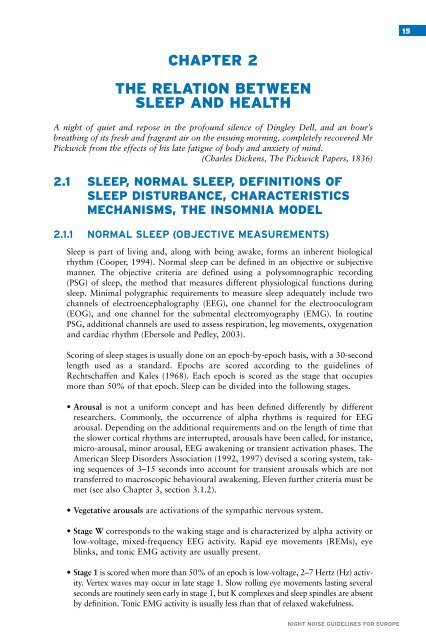Night noise guidelines for Europe - WHO/Europe - World Health ...
Night noise guidelines for Europe - WHO/Europe - World Health ...
Night noise guidelines for Europe - WHO/Europe - World Health ...
Create successful ePaper yourself
Turn your PDF publications into a flip-book with our unique Google optimized e-Paper software.
15<br />
CHAPTER 2<br />
THE RELATION BETWEEN<br />
SLEEP AND HEALTH<br />
A night of quiet and repose in the profound silence of Dingley Dell, and an hour’s<br />
breathing of its fresh and fragrant air on the ensuing morning, completely recovered Mr<br />
Pickwick from the effects of his late fatigue of body and anxiety of mind.<br />
(Charles Dickens, The Pickwick Papers, 1836)<br />
2.1 SLEEP, NORMAL SLEEP, DEFINITIONS OF<br />
SLEEP DISTURBANCE, CHARACTERISTICS<br />
MECHANISMS, THE INSOMNIA MODEL<br />
2.1.1 NORMAL SLEEP (OBJECTIVE MEASUREMENTS)<br />
Sleep is part of living and, along with being awake, <strong>for</strong>ms an inherent biological<br />
rhythm (Cooper, 1994). Normal sleep can be defined in an objective or subjective<br />
manner. The objective criteria are defined using a polysomnographic recording<br />
(PSG) of sleep, the method that measures different physiological functions during<br />
sleep. Minimal polygraphic requirements to measure sleep adequately include two<br />
channels of electroencephalography (EEG), one channel <strong>for</strong> the electrooculogram<br />
(EOG), and one channel <strong>for</strong> the submental electromyography (EMG). In routine<br />
PSG, additional channels are used to assess respiration, leg movements, oxygenation<br />
and cardiac rhythm (Ebersole and Pedley, 2003).<br />
Scoring of sleep stages is usually done on an epoch-by-epoch basis, with a 30-second<br />
length used as a standard. Epochs are scored according to the <strong>guidelines</strong> of<br />
Rechtschaffen and Kales (1968). Each epoch is scored as the stage that occupies<br />
more than 50% of that epoch. Sleep can be divided into the following stages.<br />
• Arousal is not a uni<strong>for</strong>m concept and has been defined differently by different<br />
researchers. Commonly, the occurrence of alpha rhythms is required <strong>for</strong> EEG<br />
arousal. Depending on the additional requirements and on the length of time that<br />
the slower cortical rhythms are interrupted, arousals have been called, <strong>for</strong> instance,<br />
micro-arousal, minor arousal, EEG awakening or transient activation phases. The<br />
American Sleep Disorders Association (1992, 1997) devised a scoring system, taking<br />
sequences of 3–15 seconds into account <strong>for</strong> transient arousals which are not<br />
transferred to macroscopic behavioural awakening. Eleven further criteria must be<br />
met (see also Chapter 3, section 3.1.2).<br />
• Vegetative arousals are activations of the sympathic nervous system.<br />
• Stage W corresponds to the waking stage and is characterized by alpha activity or<br />
low-voltage, mixed-frequency EEG activity. Rapid eye movements (REMs), eye<br />
blinks, and tonic EMG activity are usually present.<br />
• Stage 1 is scored when more than 50% of an epoch is low-voltage, 2–7 Hertz (Hz) activity.<br />
Vertex waves may occur in late stage 1. Slow rolling eye movements lasting several<br />
seconds are routinely seen early in stage 1, but K complexes and sleep spindles are absent<br />
by definition. Tonic EMG activity is usually less than that of relaxed wakefulness.<br />
NIGHT NOISE GUIDELINES FOR EUROPE

















